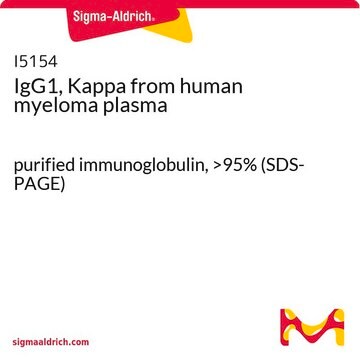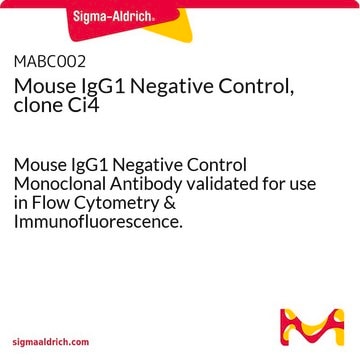M9269
IgG1, Kappa from murine myeloma
clone MOPC 21, purified immunoglobulin, buffered aqueous solution
Synonym(s):
Mouse IgG1-κ
Sign Into View Organizational & Contract Pricing
All Photos(1)
About This Item
Recommended Products
biological source
mouse
conjugate
unconjugated
antibody form
purified immunoglobulin
clone
MOPC 21, monoclonal
form
buffered aqueous solution
shipped in
dry ice
storage temp.
−20°C
target post-translational modification
unmodified
Looking for similar products? Visit Product Comparison Guide
Specificity
Specificity is determined by mouse monoclonal isotyping strips. The purified immunoglobulin preparation is non-reactive with anti mouse IgA, IgM, IgG2a, IgG2b or IgG3
Application
IgG1, κ from murine myeloma has been used in:
- the in situ hybridization experiments with bulbar conjunctiva sections
- immunohistochemistry of cattle and artery tissues
IgG1, κ from murine myeloma has been used:
- in immunofluorescence of leukocytes at a concentration of 50 μg/ml
- as a standard in enzyme linked immunosorbent assay (ELISA)
- as exchange antibody in centrifugal gel filtration
IgG1, Kappa from murine myeloma has been used in flow cytometric analysis and immunoprecipitation.
Biochem/physiol Actions
IgG antibody subtype is found in blood and extracellular fluids and provides protection from infections caused by bacteria, fungi and viruses. Maternal IgG is transferred to fetus through the placenta that is vital for immune defense of the neonate against infections.
IgG1 has a molecular weight of 146 kDa and is an abundantly expressed IgG subclass. IgG1 deficiencies contribute to overall decrease in total IgG levels resulting in hypogammaglobulinemia. IgG1 promotes bacterial phagocytosis and mediates vaccine-induced protection from infection. The ratio of IgG2a to IgG1 is crucial for the immune response against Leishmania tropica infection. It has high binding affinity towards the Fcγ receptors (FcγR). High levels of IgG1-κ antibodies is associated with the pathology of glomerulonephritis.
Physical form
Solution in 0.02 M Tris buffered saline, pH 8.0, containing 0.02% sodium azide
Storage and Stability
Store at −20 °C. The product may be stored frozen in working aliquots at −20 °C. Repeated freezing and thawing is not recommended.
Disclaimer
Unless otherwise stated in our catalog or other company documentation accompanying the product(s), our products are intended for research use only and are not to be used for any other purpose, which includes but is not limited to, unauthorized commercial uses, in vitro diagnostic uses, ex vivo or in vivo therapeutic uses or any type of consumption or application to humans or animals.
Storage Class Code
10 - Combustible liquids
WGK
WGK 3
Flash Point(F)
Not applicable
Flash Point(C)
Not applicable
Personal Protective Equipment
dust mask type N95 (US), Eyeshields, Gloves
Certificates of Analysis (COA)
Search for Certificates of Analysis (COA) by entering the products Lot/Batch Number. Lot and Batch Numbers can be found on a product’s label following the words ‘Lot’ or ‘Batch’.
Already Own This Product?
Find documentation for the products that you have recently purchased in the Document Library.
Customers Also Viewed
Phillip A Doerfler et al.
Clinical immunology (Orlando, Fla.), 158(2), 140-147 (2015-04-07)
Antibodies formed against the therapeutic protein are a life-threatening complication that arises during enzyme replacement therapy for Pompe disease (acid α-glucosidase deficiency; GAA). To provide an effective alternative to current practices, we investigated the capacity of anti-B-cell activating factor (BAFF)
Circulating monoclonal IgG1-kappa antibodies causing anti-glomerular basement membrane nephritis.
Vankalakunti M, et al.
Indian journal of nephrology, 27(4), 327-327 (2017)
Cecilia Lässer et al.
Journal of visualized experiments : JoVE, (59), e3037-e3037 (2012-01-20)
The field of exosome research is rapidly expanding, with a dramatic increase in publications in recent years. These small vesicles (30-100 nm) of endocytic origin were first proposed to function as a way for reticulocytes to eradicate the transferrin receptor
G G de Sá Oliveira et al.
Clinical and experimental immunology, 105(2), 313-320 (1996-08-01)
The specificities of a panel of erythrocyte-reactive MoAbs derived from NZB mice with autoimmune haemolytic anaemia (AIHA) were determined by immunoprecipitation and immunoblotting. Of the eight antibodies, two (IgG1 MoAb 105-2H and IgG2a MoAb 34-3C) immunoprecipitated a 105-kD component identified
The relative contribution of mast cell subsets to conjunctival TH2-like cytokines.
Anderson DF, et al.
Investigative Ophthalmology & Visual Science, 42(5), 995-1001 (2001)
Our team of scientists has experience in all areas of research including Life Science, Material Science, Chemical Synthesis, Chromatography, Analytical and many others.
Contact Technical Service












